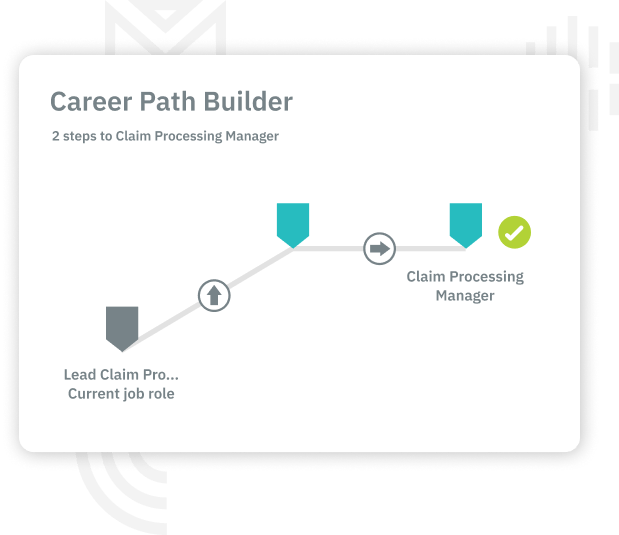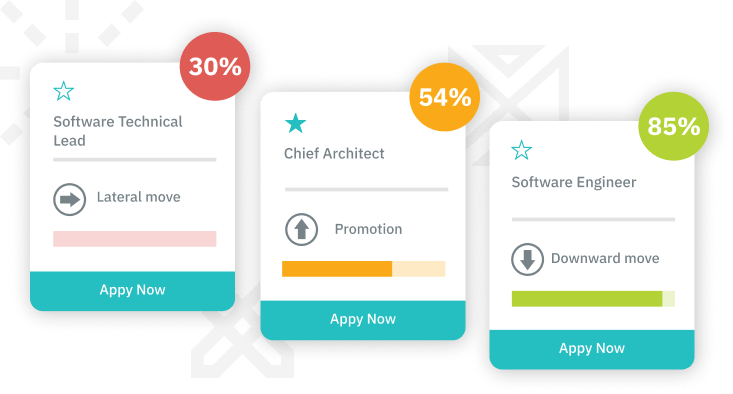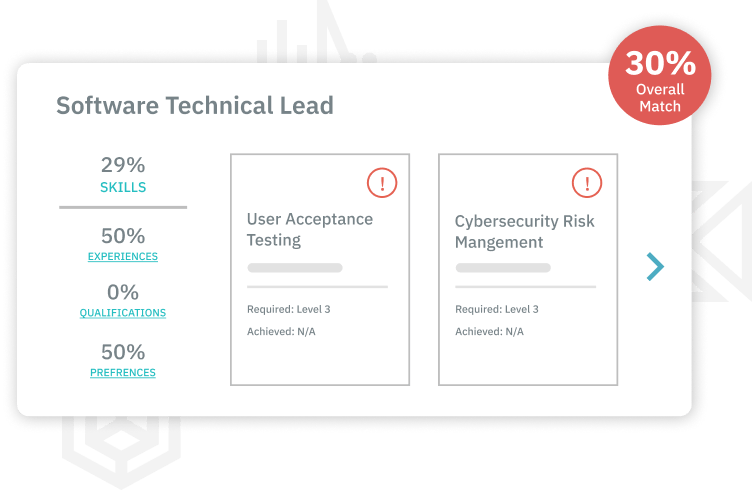Talent Mobility Framework
Help employees navigate a future role in your company
Our platform provides the talent mobility framework needed for employees to see all the opportunities your company offers, so they can clearly envision and work towards a career path that aligns with their skills and life plans.

Visibility that sparks initiative
Employees can actively explore their possibilities within the company and build career paths tailored to their competencies and goals, whether they’re aiming for the top or happy where they are.

Agile matching of people and roles
Our competency-based search functions allow employees to search for roles that fit their skills and dreams. This increases internal mobility from the bottom up, helping your company retain its valuable talent.

Growth with purpose
When employees set their sights on a career path, they get a custom development plan based on their current competencies, so they can acquire the skills their desired roles demand.
Get Your Free Demo & See our Platform in Action
Select from one of the bundles below and we will tailored the demo to your needs. Let us show you how TalentGuard’s solutions adapt to your industry.
Free Trial
Free to start
$0
Upfront Commitment
(No hidden charges)
A competency management system loaded with pre-built competencies and job models, designed to streamline skill development, job role creation, competency mapping, and talent management for your organization.
Restrictions apply so please read the eligibility criteria.
Automate
Transform the way your organization defines, manages, and evolves job roles with WorkforceGPT—the AI-powered solution that rapidly generates comprehensive job profiles, skills taxonomies, and career progression maps tailored to your workforce.
WorkforceGPT tracks millions of data points to generate precise, standardized, and up-to-date job architectures—all in a fraction of the time it takes with traditional methods.
With our AI-driven system, you can:
- Create Smart Job Descriptions – Standardize language and tone across roles effortlessly.
- Build AI-Powered Skills Taxonomies – Define skills, clusters, and proficiency statements with accuracy.
- Seamlessly Map Skills to Roles – Align required skills and proficiencies across job grades.
- Enable Dynamic Career Pathing – Real-time updates based on employee movement.
- Deliver Personalized Learning Paths – Address individual skill gaps with just-in-time development.
- Gain Predictive Skill Insights – Stay ahead of workforce demands.
Engage
Employees need clear career paths, relevant skills development, and personalized learning opportunities to stay ahead. TalentGuard’s Engage Package leverages AI to provide employees with real-time upskilling, career pathing, and development planning that aligns with organizational needs.
What’s Included in the Engage Package? Everything in Automate, plus:
- Talent Assessment – Gain deep insights into employee skills, experiences, qualifications and areas for growth.
- AI-Powered Career Pathing – Help employees visualize and navigate career opportunities within your organization.
- Personalized Development Planning – Deliver real-time, skill-based learning recommendations tailored to each employee.
- Talent Analytics – Dashboards and reports to help you make data-driven decisions in a snap.
Optimize
The workplace is evolving, and so are the demands on leadership. TalentGuard’s Leadership Optimization Packagehelps organizations navigate generational transitions, build strong leadership pipelines, and adapt to new work paradigms with AI-driven precision.
What’s Included in the Optimize package? Everything in Engage, plus:
- Succession Planning – Identify and develop high-potential talent pools to ensure a seamless leadership transition.
- Performance Management – Set goals, provide feedback, and track performance for leadership growth.
- Certification Tracking – Ensure leaders maintain essential credentials and compliance effortlessly.
- 360 Feedback – Conduct multi-rater leadership assessments to develop well-rounded, high-impact leaders.
Trusted by:




Your workforce is changing. Never be unprepared again.
Read our eBook
Additional information
A talent mobility framework is a strategic approach that organizations use to manage and enhance internal mobility. It helps ensure that employees are placed in roles that not only align with their skills and career aspirations but also meet the business’s evolving needs. The core purpose of a talent mobility framework is to create a system where employees can transition between roles effectively, leveraging their strengths to drive organizational success.
So, what exactly is talent mobility? In essence, talent mobility is the ability of an organization to be flexible in identifying and utilizing the various skill sets within its workforce. It means having the agility to move employees from one role to another, ensuring that each individual is placed where they can contribute most effectively and grow. This strategy not only enhances individual success but also ensures that the company can adapt to changing market demands, fill critical positions, and remain competitive.
By implementing a talent mobility framework, companies can clearly define their internal mobility policies and set targeted goals for leadership and workforce development. This framework creates a structured pathway for employees to explore different career opportunities within the organization, resulting in higher engagement, retention, and job satisfaction. Employees are more likely to feel valued and motivated when placed in roles that align with their strengths, leading to better performance and overall organizational growth.
Ultimately, a talent mobility framework formalizes internal mobility processes, making them transparent and actionable. It provides a clear roadmap for both employees and leaders, ensuring that the company’s talent is utilized to its full potential while supporting long-term business objectives. This approach fosters a culture of continuous learning and development, where talent can flourish, and the organization can thrive.
Check out TalentGuard Workforce Intelligence Platform by requesting a demo. We can have a talent mobility framework up in running in weeks.
Internal Mobility Programs
With this in mind, how can internal mobility programs support the successful outcomes you’ve built within your framework? Companies with internal mobility programs typically start with a benchmark or reference point and set metrics from there so they can measure successes and opportunities moving forward.
Your internal mobility process should be designed such that it focuses on:
- Helping your team fill vacant roles and positions more quickly
- Improving employee engagement and retention
- Empowering your existing talent pool
When you have internal mobility metrics in place, you’re more likely to identify gaps, opportunities, and goals that your organization should be focusing on. As stated, you’ll need to start with an internal mobility benchmark for each metric you want to measure to ensure you’re starting with a baseline and know where you are at the very beginning of the process.
As you build out your talent mobility framework, think about these questions:
- What percentage of our open positions are being filled internally? Be careful not to examine this solely on a broad scale. In other words, be sure to examine the numbers across departments, as well as cross your entire organization. If you have a high rate of positions being filled internally by a few departments, this can skew your overall results. Instead, compare those internal hires across different functions so you can see if internal mobility is not being adopted by your entire company as a whole.
- Are you keeping tabs on manager-related internal mobility metrics? Your employees should feel comfortable talking about their career aspirations with their bosses. Unfortunately, not every supervisor is great at career coaching. Make sure your organization is checking in on managers’ histories with regard to promoting internal mobility.
- Are you measuring metrics around the nature of mobility? Bear in mind that the old way of thinking about talent mobility largely centered around promotions. Sure, this is still one way to measure internal mobility, but as many organizations have flattened over the years, many metrics surrounding talent mobility revolve around lateral moves. As you examine your metrics, consider calculating your percentages within the following three buckets: promotions, job function changes, and business unit changes. Bear in mind that some moves could potentially fall into multiple categories, so it’s possible for your percentages to exceed greater than 100%.
- Are you incorporating diversity and inclusion ratios? Your diversity and inclusion metrics need to compliment your other human resource policies. It’s vital that you assign responsibility and establish accountability to the individuals or departments who will be monitoring the implementation of each strategy. From there, you can analyze and track results to make sure your company is making progress. Maximize transparency by reporting your findings to managers, employees, and other organizational stakeholders.
Internal Mobility Best Practices
When it comes to internal mobility best practices, every organization will be a little different. Your goals and objectives may vary greatly from those of your closest competitors, so it’s important to know your own companies culture and needs before you dig into the details.
Although each internal mobility policy will vary, there are a few tried-and-true talent mobility best practices you should incorporate into your talent mobility strategy from the very beginning.
1. Get Buy-In from Leadership
Your recruiters and HR managers aren’t the only people affected by your internal talent mobility strategy; team leaders and their subordinates are also stakeholders in these processes. As such, you need to raise awareness about your goals and objectives as you implement your new talent mobility framework, making sure to present tangible benefits that everyone can understand and get on board with.
It’s not always easy to get support for new concepts. You’ll likely need to do your homework before presenting this idea to leadership. Start by identifying those who support you, then work with them to define your objectives, implementation resources, and time constraints. This will help ensure your pitch gets the most support from your company’s superiors.
2. Launch an Internal Mobility Program
Internal job boards don’t always do the trick when you’re trying to get the word out about internal openings. This is where internal mobility programs come in handy. Enable your recruiters and hiring managers to pair opportunities with existing employees who fit the necessary skills and capabilities by giving your staff a platform through which they can highlight their expertise. Be sure to utilize elements such as company-wide Slack channels and bulletins to garner attention to your efforts.
3. Redefine Your Recruitment Processes
Sometimes, you have to step out of the old way of doing things. To meet new challenges, your recruitment team might need to rework its conventional practices.
Put some time and money into efficient recruitment marketing tactics and talent sourcing. With the right tools, you’ll be able to source and recruit talent within your organization more easily and effectively.
